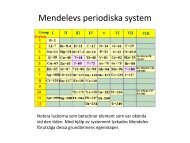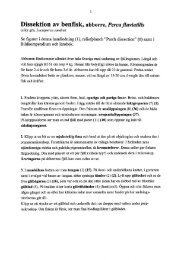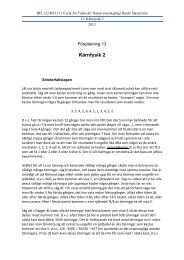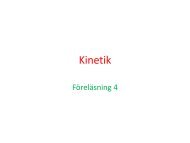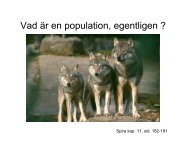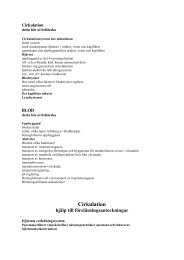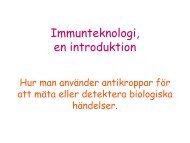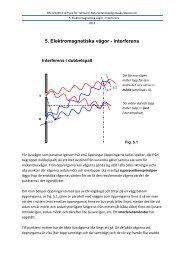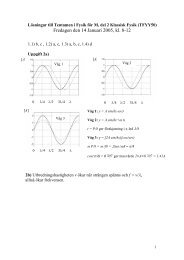Biosensors and Bioelectronics - IFM - Linköping University
Biosensors and Bioelectronics - IFM - Linköping University
Biosensors and Bioelectronics - IFM - Linköping University
Create successful ePaper yourself
Turn your PDF publications into a flip-book with our unique Google optimized e-Paper software.
Loss in hybridisation, melting of the duplex results<br />
in a reduction in the electrochemical response.<br />
Studies of the melting temperature of probe/PCR<br />
product are foreseen as an improved method to<br />
allow rapid <strong>and</strong> effective identification of specific<br />
genetic sequences.<br />
Salivary Amylase (sAA) as a Stress Marker.<br />
NovaMedTech, New Tools for Health <strong>and</strong><br />
Innovation Bridge (2011-2012), 1m SEK.<br />
A pilot study on the associations between sAA,<br />
psychosocial factors, self-rated health <strong>and</strong><br />
inflammation markers has been conducted in<br />
cooperation with researchers at the Health<br />
<strong>University</strong> having a saliva bank within a study called<br />
Life conditions, Stress <strong>and</strong> Health. Levels of sAA<br />
just after awakening were positively associated with<br />
depression scores <strong>and</strong> level of ongoing<br />
inflammation, <strong>and</strong> negatively associated with selfrated<br />
health. Levels of sAA 30 minutes after<br />
awakening <strong>and</strong> just before going to bed point in the<br />
same direction, but may be influenced by recent<br />
daily activity to a higher extent. The findings<br />
support the hypothesis that sAA might be a reliable<br />
marker of ANS activity in saliva.<br />
Reaction kinetics due to amylase activity can be<br />
measured with simple instrumentation using a light<br />
source (LED) <strong>and</strong> a detector (phototransistor) or<br />
with a disposable plastic electrochemical strip.<br />
Preliminary comparison with an established method<br />
for determination of saliva amylase activity is shown<br />
below. Pink triangles = measurements on diluted<br />
saliva, blue = st<strong>and</strong>ard method.<br />
4,00<br />
3,50<br />
3,00<br />
2,50<br />
2,00<br />
1,50<br />
1,00<br />
0,50<br />
Calibration curve<br />
0,00<br />
0 20000 40000 60000 80000 100000 120000<br />
A spin-off has been initiated to develop a<br />
commercially viable biosensor system to monitor<br />
wellness <strong>and</strong> therapy effectiveness <strong>and</strong> about one<br />
million SEK in seed funding from several Swedish<br />
innovation funding agencies has been secured. A<br />
preliminary market study has been completed <strong>and</strong><br />
initial contacts for clinical studies have been<br />
established. With support from LiU Innovations <strong>and</strong><br />
Uppsala <strong>University</strong> patent office, the patent strategy<br />
is underway. Activities continue to develop a<br />
prototype <strong>and</strong> conduct a clinical benefit study, which<br />
are fundamental to demonstrate commercial<br />
viability. The success of this endeavor demonstrates<br />
how our research can generate applications that<br />
improve quality of life <strong>and</strong> increase the<br />
sustainability of healthcare.<br />
Reagent paper Instrumentation<br />
Skin Emissions studies for Bed Sore Prevention.<br />
NovaMedTech<br />
Pressure ulcers are a major problem for bed-ridden<br />
patients, causing pain <strong>and</strong> intense suffering for the<br />
individual. Furthermore, treatment is very costly <strong>and</strong><br />
labour intensive. A lot can be gained therefore if<br />
early precursors of pressure ulcers can be spotted<br />
<strong>and</strong> measures taken before an ulcer occurs. In<br />
collaboration with researchers at the Health<br />
<strong>University</strong> in <strong>Linköping</strong> <strong>and</strong> at the <strong>University</strong> of<br />
Rome “Tor Vergata”, we have performed an initial<br />
study to find out if there is a difference in the<br />
emissions from the skin of compressed tissue<br />
compared with uncompressed tissue. The<br />
experiments were performed on hospitalised patients<br />
in an intensive care unit <strong>and</strong> on healthy volunteers.<br />
This GC-MS study indicates that difference in<br />
general emission patterns are seen between<br />
hospitalised <strong>and</strong> healthy people, respectively.<br />
Furthermore within each group it was possible to<br />
differentiate between compressed <strong>and</strong> uncompressed<br />
tissue. This lays the foundation for the development<br />
of smart technology to prevent this costly <strong>and</strong><br />
damaging trauma.<br />
Artificial Olfaction<br />
A further collaboration with the <strong>University</strong> of Rome<br />
“Tor Vergata” in the area of artificial olfaction <strong>and</strong><br />
colour indicators for volatile organic compounds has<br />
resulted in improved modeling of the olfactory<br />
system based on optical chemical sensing, where<br />
each pixel in a response image is regarded as an<br />
olfactory receptor neuron. Our results indicate that<br />
the average firing rate of the output spike sequences<br />
shows the best separation among the experienced<br />
vapours, however the latency code is able in a<br />
shorter time to correctly discriminate all the tested<br />
volatile compounds. This behavior is qualitatively<br />
similar to those recently found in natural olfaction,<br />
<strong>and</strong> in particular it provides a practical route to tailor<br />
the measurement conditions of artificial olfactory<br />
systems, defining for each specific case a proper<br />
measurement time<br />
<strong>Bioelectronics</strong><br />
We are currently focusing on electroactive surfaces<br />
<strong>and</strong> scaffolds for regenerative medicine as a part of<br />
the LiU Integrative Regenerative Medicine (IGEN)



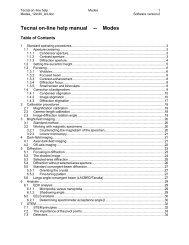
![Read more [PDF] - IFM - Linköping University](https://img.yumpu.com/51852190/1/184x260/read-more-pdf-ifm-linkoping-university.jpg?quality=85)
